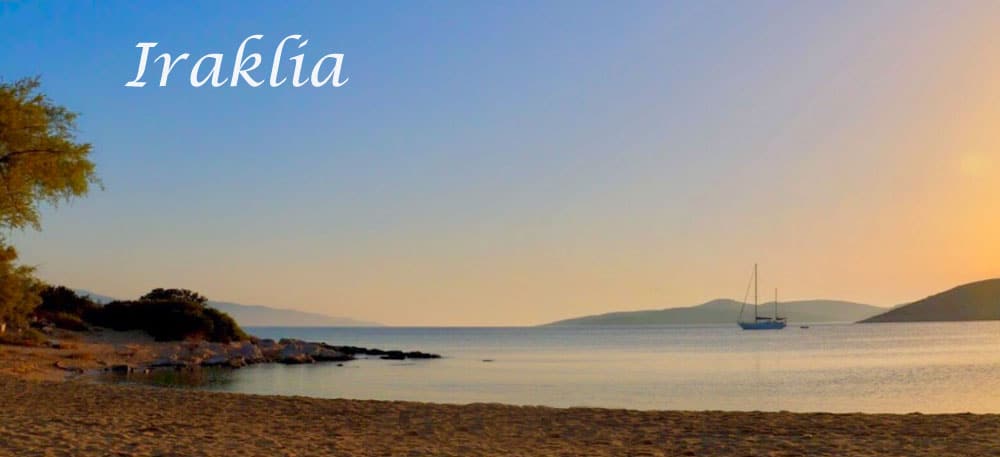Information about Iraklia
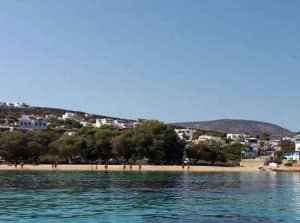
If you are also in a state of searching for a new place that will offer you quiet and relaxing holidays that will help you eliminate the tension of the difficult winter that passed, all roads lead to Iraklia.
Here the concept of relaxation takes on a real meaning, as you will find just what you need for your vacation (beaches, accommodation, food) in both and all settlements of the island, while if you are in the mood for hiking, you can go around the whole island on foot within three hours!
You may be impressed by the name – even if you have never heard of it – but this is the next big thing of the Cyclades, which will soon become widely known and flooded with people. For now, this magical island is enjoyed by the few who know it and vote for it every year.
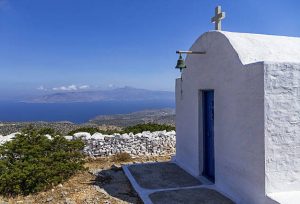
In Chora and Panagia, the two settlements of the island, you will find picturesque taverns, bars, small cafes, a grocery store, an ATM and the regional doctor’s office. Nothing will distract you more than this picturesque island where blue and white are constantly alternating and Cycladic architecture dominates.
As soon as you arrive at the port of Agios Georgios, you will immediately feel the need to leave behind the tension of the city and indulge in the simplicity of the island life.
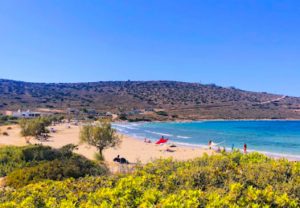
The second settlement, which is worth reaching by walking from the ancient dirt path, stands imposingly and resembles a film set from an old Italian film. On the routes of the main road there are houses that date back to a long time ago and you will stop at the women who are either doing business or resting on a terrace. Old ladies with their gray hair tied in a bun under a scarf, with their thin, sun-burnt face and an observant gaze that embraces you from a distance.
The sound of the herds can be heard from the distance, the threshing floors stand out characteristically, and in the only shop of the settlement, everyone gathers to enjoy the view, the quiet and the company, eating homemade delicacies. Pies, traditional sweets and coffees on the embers, which match in a unique way with the mountainous landscape of the once barren line.
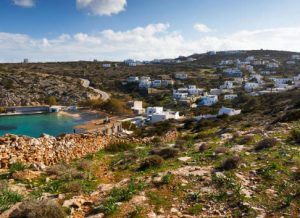
The houses fit harmoniously into the Cycladic architecture and the cobblestones with the whitewashed joints create a dreamlike setting.
An asphalted road connects the port with the Town of Iraklia, Panagia. Panagia is a traditional settlement at the foot of Mount Papas. The settlement is located at a distance of 4.5 km from the port and about 2 km from Turkopigado beach.
Iraklia is suitable for peaceful holidays in its heavenly landscape with beaches in green, turquoise and blue water shades. It is aimed at those who are fascinated by the tranquility and simplicity of island life.Iraklia is an ideal destination for alternative holidays.
Mythology
According to mythology, on his return journey to Ithaca after the Trojan War, Odysseus stopped at Iraklia to pay his respects to Zeus. In order to protect the boat from the strong winds, it anchored for the night at the beach of Alimia.
However, no one knew that the Cyclops Polyphemus, son of the God Poseidon, resided in the caves beyond the hill. So when Odysseus started to climb the hill, he was captured and imprisoned in the great cave.
Although Odysseus devised an escape plan, Polyphemus discovered it and began throwing high rocks to sink the ship. The Cyclops missed his target and the rocks are known today as the Small and Great Avella Islands.
History
Iraklia owes its name to the mythical hero Herakles and has preserved it from antiquity to the present day. Little is known about the history of the island. Reduced excavations have brought to light findings of the Cycladic Civilization, while there are indications that the island continued to be inhabited during the Classical and Hellenistic periods.
Life in Iraklia continued even during the Turkish occupation. For a while it belonged to the monastery of Panagia Hozoviotissa of Amorgos, and Amorgians settled in the 19th century on the island, establishing three settlements: Agios Athanasios, which today is almost abandoned, Panagia and Agios Georgios, which are still inhabited. Some lived in the houses of the Castle, which have been completely demolished.
There are indications that the island was inhabited during prehistoric times and especially during the Proto-Cycladic II Era (2800-2220 BC). This is evidenced by the prehistoric settlements at the sites of Kampos Agios Athanasios, Agios Mamas, Kastro, as well as various finds (bottles, figurines, spears, compasses, chisels, peleceis), typical works of art of the Cycladic Culture. Many of them, all products of antiquities, today adorn foreign private collections and museums.
A very important find, originating from Iraklia, is exhibited in the Metropolitan Museum of New York. This is a statue head, 31 cm high.
At the Kastro site there are remains of a fortress from the Hellenistic Age and the foundations of an ancient building, probably a temple dedicated to the worship of the Goddess Tychi and Lofitis Zeus.
This building also shows later construction phases. However, some of the materials used (e.g. for the superstructure) are from an earlier era. In this area there are also two statue bases that testify to the religious function of the area and an olive press. In addition, sherds (vessel fragments) dating to the 5th and 4th centuries BC were found.
Since 1928, Iraklia has been a separate community with a population of 286 inhabitants. It is worth noting the resistance reaction of the Iraklians during the German occupation. The coves of Voreini Spilia and Turkopigado were a refuge and base for Greek and allied commandos and saboteurs.
Geography
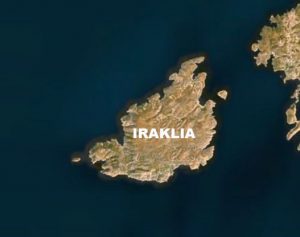
The island has a relatively indented coastline, which is around 18 kilometers (11 miles) in length. It features a mix of rocky cliffs, small bays, and secluded beaches. The shoreline offers picturesque views and opportunities for swimming and relaxation.
Iraklia is known for its natural beauty and unspoiled environment. The island is relatively untouched by mass tourism and offers visitors a serene and tranquil atmosphere. The landscape is dotted with olive groves, vineyards, and fields, creating a picturesque countryside.
Economy
Most of the residents who remained on the island, mostly middle-aged and elderly, are mainly engaged in agriculture, animal husbandry and fishing. Some individuals are active in the trade and service sectors, while a limited number are engaged in tourism businesses. The tourism development of the island is limited due to the lack of infrastructure and the limited number of tourists.
The main sector on which the island’s economy is based is agriculture, animal husbandry and construction, while during the summer months tourist activities are developed, mainly by locals who live in Athens. For the other sectors (office workers, trade, transport) employment is extremely low. As far as fishing is concerned, a small degree of employment is observed. Only a few professional fishermen own large boats.
The inhabitants of Iraklia, despite the scarcity of water and the limited fertile areas of their island, have always engaged in agriculture, not always for livelihood reasons, but to satisfy their household needs for agricultural products. Already from the time when the island belonged to the monastery of Panagia Hozoviotissa, the inhabitants cultivated mainly wheat, barley and pulses.
Until a few years ago, growing conditions were almost primitive. Farmers plowed their fields with mules or donkeys and the harvest was done by hand, while the fruit was picked on stone threshing floors. Many such threshing-floors still survive today. however, most are not visible, as they have been covered by bushes and grasses.
Today, farming conditions have not changed much, except for the introduction of minimal modern agricultural machinery. The type of crops are mainly cereals, fava beans, fruit and vegetables (characteristic is a type of small tomato, which the locals call “koumenderi”) and a few olives. Those of the residents who are professionally engaged in agriculture channel their products to taverns and grocery stores on the island
What to see
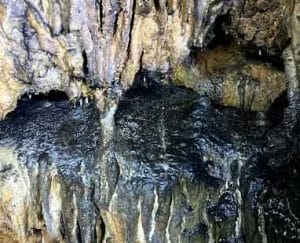
It is one of the most important attractions of the island and the Aegean – and the largest of the Cyclades.
There was also found the icon of Saint John the Forerunner, who gave the cave its name. Opposite the entrance of the cave is a smaller cave, named Cyclops Cave.
According to legend, he was blinded by the resourceful Odysseus to escape with his men. Iraklia is also famous for its paths. The path to Prophet Ilias, as well as the one from Ormos tou Mericha, leads to one of the highest points of the island, with a view that will remain unforgettable.
On the path that leads to the Castle above Livadi you can observe the ruins of a Hellenistic period castle as well as the ruins of the temples of Zeus and the Goddess of Fortune.
Events & Festivals
Every April 23, the traditional celebration in honor of Saint George takes place in the village of Saint George. Every fifteenth of August, the traditional celebration in honor of Panagia takes place in the village of Panagia.
Every August 29 in the Cave of Agios Ioannis the established celebration in honor of Agios Ioannis takes place. On August 28, Vespers takes place inside the cave of Agios Ioannis under the light of hundreds of candles, creating an awesome atmosphere of darkness and mysticism.
Every November 9, the traditional feast in honor of Agios Nektarios takes place in the church of Agios Nektarios in the village of Panagia. After the liturgy, the parish offers food, sweets and wine to the pilgrims.
Although small and not so well known, Heraklia is a beautiful Greek island with pristine beauty, peaceful atmosphere and welcoming climate. For lovers of tranquility, inner peace and harmony with nature, Heraklia is the ideal choice to enjoy your holidays next year.
Flora and Fauna
Iraklia, like other Cycladic islands, typically features a Mediterranean climate, which influences its vegetation. The island’s flora is characterized by drought-tolerant plants adapted to the arid conditions.
The wildlife on Iraklia and the surrounding Cyclades islands is influenced by their isolation and the surrounding marine environment. The island serve as a stopover for migratory birds, and various species can be spotted, including gulls, falcons, and hawks. The surrounding waters are known for their rich marine biodiversity, including fish, crustaceans, and mollusks.
Beaches
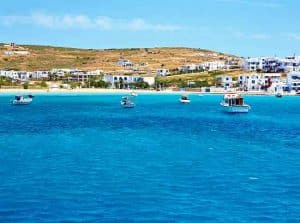
Livadi is about 2 km from the port and is the largest beach of the island which overlooks Schinoussa. On the days when the meltemi winds make an appearance, you must go to the sheltered Turkopigado cove, with pebbles and clear turquoise waters.
The most famous beach of the island, Alimia, is only accessible by boat from the port. It is known for the seaplane that sunk there during World War II which is visible even from the surface of the sea.
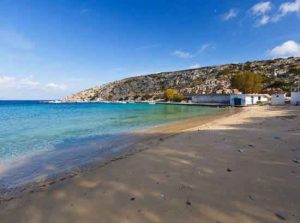
In Iraklia you will find beaches with crystal clear, blue waters, some with sand and others with pebbles.
The port of Agios Georgios with its sandy beach is the closest solution, as is Livadi, with a long sandy beach and shallow waters, which makes it ideal for families with children.
From Livadi you have a view of Schinousa, but also of the opposite island, Venetiko.
Another well-known – and accessible by road – beach is Turkopigado, a long, narrow beach with pebbles, which you can also reach by foot. It will reward you with its pure beauty.
Vorini Spilia is a very quiet and beautiful beach located in the northern part of the island, quite close to Agios Georgios. It has a soft sandy beach while its waters are crystal clear and transparent, due to the northerly wind that blows non-stop.
Accessible by boat or boat are two of the most beautiful beaches of the island, Alimia and Karvounolakkos.
The first is sandy with blue-green waters and is considered ideal for diving, since a German seaplane that was shot down during the Second World War “hides” in its waters, while the second is a small beautiful beach with crystal clear waters.
Excursions by boat and speedboat take place daily to the beaches that are not accessible, but also to the beaches of neighboring islands, such as Schinoussa.
The villages of Iraklia
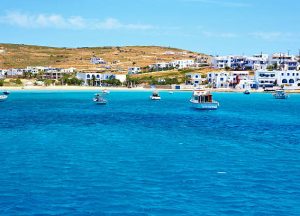
Chora, also called “Panagia”, is only 4 km from Agios Georgios and in it you will be transported to a setting taken from another era: very old houses, in the shape of small cubes, and an atmosphere where time – and life- flow at different rates. The view from Chora to the sea and the surrounding islands is unique.
The names of the settlements come from the churches of the same name that have been erected in them, especially that of Panagia, which is dedicated to Virgin Mary. Construction work began in 1919 until 1930 and was finally completed in the 1980s. In contrast, the church of Agios Georgios, in the settlement of the same name, is older, reportedly built in 1834 and renovated in 1987.
What to do
Iraklia, which is an impressive mountain mass with excellent beaches protected from strong winds thanks to its proximity to the large mountainous islands, Naxos and Ios, is the “wild beauty” in the Lesser Cyclades. Included in the Natura 2000 network, it fascinates with the wonderful views offered by its mountain paths, the variety of its coasts and its own, unique, attractions. Small in size but very important, the island is a place of hospitality for the Mediterranean seal monachus monachus and the sea turtle caretta caretta.
Castle Archaeological Site
The Castle Archaeological Site is the best-preserved archaeological site of the island, located above Livadi Bay. The Castle was the acropolis of the Hellenistic period. Here one can admire the remains of houses, courtyards and threshing floors along with the ruins of two temples dedicated to the god Zeus.
Inland explorations
Agios Athanasios is a deserted village located on the western side of the island. The abandoned settlement presents an interesting arrangement of traditional Cycladic architecture. The village is accessible via a dirt road that starts from the main road of the island.
Mysterious Islands
Mikros Avellas, Megalos Avellas and Venetiko. Board the traditional boats to visit the deserted beaches of the islands of Heraklion. You will have the opportunity to enjoy the crystal clear waters of the Avelonisia and Venetiko islands!
The Livadi Castle where there are the ruins of a Hellenistic period castle, as well as ruins of the Temple of Zeus and the Temple of the Goddess of Fortune, but also the settlement of Agios Athanasios which today is almost abandoned but presents an interesting landscape with Cycladic architecture .
The bay of Mericha, on the south-eastern side of the island, is surrounded by vertical rocks with a height of more than 100 m, in the opening of which birds find natural nests.
The view is breathtaking and you can enjoy it with a boat ride or take the path from Panagia that leads to the place Ftero Mericha and admire the vertical, steep rocks of the famous Ormos from above.
Where to stay
Although the island is small, it has accommodation options. Of course it’s a good idea not to book at the last minute, so you don’t face a problem with availability and prices.
One of the most famous accommodations is the Villa Zografos, 700 meters from Livadi beach. It has six nice and simple rooms with their own veranda overlooking the islet of Venetiko, the Castle, the beach and the rest of the Small Cyclades.
The Speires hotel, built amphitheatrically and offering a unique view of the Aegean from the settlement of Agios Georgios, has 8 spacious and fully equipped double and triple rooms as well as two suites with large terraces.
At a distance of 100 meters from the port, you will also find the Maistrali Seamen’s Club, with its simple, traditional and comfortable studios and rooms, which all have a view of the sea.
The Agnandema studio complex consists of 9 double and triple rooms, equipped with air conditioning, TV and refrigerator, all of which have large private terraces with panoramic views of the sunset, the sea and the village.
Local food and cuisine
Iraklia is a small place but very interesting in terms of food as well. On the island you will find excellent fish, fresh and affordable, but also amazing goat in nice recipes and variations.
In Iraklia there some good choises for tasteing the Greek food in the local taverns. In Maistrali for cooked food, in Aiolos for pizzas, pasta and the best goat on the island, gazing at the infinity of the Aegean as the sun sets, in the tavern Thalassa in Livadi for whatever your appetite desires and in the tavern Sto Syrma overlooking the small port of Heraklia for good meat and homemade creations.
Also, in Akathi and Perasma for crepes and waffles, in En Lefko for pancakes, while a stop in Melissa is mandatory. This is a Cycladic grocery store where you go in, get what you want and, of course, mingle with the rest of the island – if you’re lucky, you’ll find yourself in front of some island feast. For the evening hours, for a drink or a cocktail, at the Surfin Bird on the beach.
When to go
The best time to visit Iraklia depends on your preferences and the activities you plan to engage in. Overall, the best time to go to Iraklia for most tourists is during the summer months when the weather is warm, and all tourist amenities are open. However, if you prefer a more relaxed and less crowded experience, consider visiting during the spring or autumn seasons.
Summer (June to August): This is the peak tourist season in Iraklia, with warm temperatures ranging from 25°C to 35°C. The sea is pleasantly warm for swimming and water activities. However, keep in mind that this period can be crowded with tourists.
Spring (April to May) and Autumn (September to October): These shoulder seasons offer milder temperatures, ranging from 15°C to 25°C. The weather is generally pleasant, and the island is less crowded compared to summer. It’s a great time for hiking, exploring the natural landscapes, and enjoying quieter beaches.
Winter (November to March): Iraklia experiences a mild winter with temperatures ranging from 10°C to 15°C. This is the offseason, and many tourist facilities may be closed during this time. However, if you prefer solitude and tranquility, this can be a good time to visit.
How to move around
It is very important to know in advance that there are no buses or taxis in Iraklia. There is only one bus that serves to transport visitors and locals from Agios Georgios to Panagia and to the beach of Turkopigados. In case you wish to rent a means of transport, the island operates the Rent a scooter-Iraklia, which rents mopeds.
Given the size of the island, many visitors prefer to explore on foot. This can be a great way to experience the natural beauty of the island and take in the sights at a leisurely pace. There are several walking trails that you can follow, and the terrain is relatively mild.
Hiking trails
Iraklia is famous for its walking routes. Wild landscapes, breathtaking cliffs and endless views of the rest of the Lesser Cyclades are all that fascinate sports fans. For example, the path to Prophet Ilias as well as the one after Merichas Cove, which leads to one of the highest points of the island, are among those that do not fade from memory.
The gaze meets the incomparable beauty of the Aegean: you observe the vultures that have created their nests in holes in the rocks, the hawks, the ospreys and the vultures flying above your head. Also, the path to the old settlement of Agios Athanasios as well as the one to the beach of Vorini Spilia are among the best of the total eight numbered paths on the island.
Finally, it is worth following the path that leads to the Castle above Livadi, where until 1930 there was a settlement and you can observe the ruins of a Hellenistic period castle as well as the ruins of the temples of Zeus and the Goddess of Fortune. As you walk, you can smell or pick oregano, thyme or rosemary, which are available in abundance.
How to get there
From Piraeus there is a ferry route to Iraklia three times a week and the journey takes about 6 hours. The island has two ports from which ships arrive and depart from Piraeus, Naxos and the surrounding islands, which are covered with daily routes (except Sunday) by the “Skopelitis”. The distance from Naxos by ferry is about one hour.
There are ferry routes to and from Piraeus (2-3 times a week), Naxos (daily), the rest of the Lesser Eastern Cyclades , Astypalaia and the Dodecanese increased the possibility of visiting the island.
